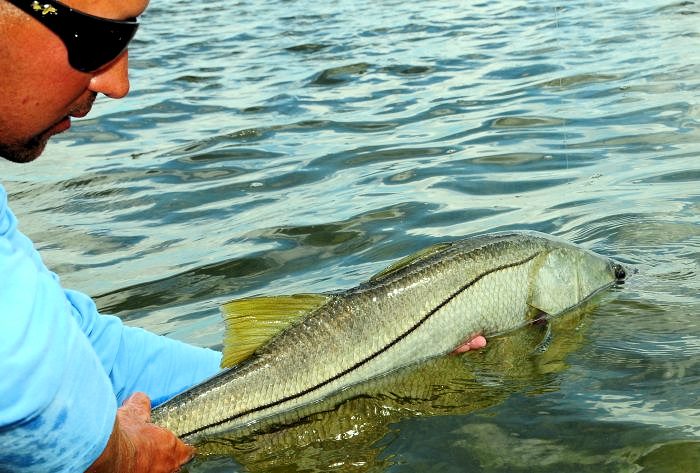Are You Making These 3 Deadly Mistakes When Releasing Snook?
By: Joe Simonds
The Top 3 Mistakes Anglers Make When Releasing Snook.
Mistake #1 – Breaking A Snook’s Jaw
An angler holds a snook by the lip with the full force of the snook’s body being supported by the jaw
Imagine if you broke your entire jaw today…
Do you think it would be tough for you to eat tomorrow?
Do you imagine that you might lose a bit of weight and be on more of a liquid diet while your jaw healed enough where you could open your mouth fully, chew regularly, and eat like normal?
Of course.
And that is exactly what happens when a snook has its jaw broken by an angler holding it up by the jaw with no support anywhere else.
But with one slight difference… a snook CANNOT go to a doctor or get on a liquid diet while it waits for its jaw to heal like a human can!
If a snook gets released back into the water with a broken jaw, here is what happens:
- It can’t eat like it normally would
- It quickly loses strength just like a human would if we didn’t eat
- It dies from either starvation or from being easily hunted down by a shark, porpoise, goliath grouper, etc.
Not to mention, if a really large snook is held vertical by its lower jaw with zero support, not only are the chances high that you break his jaw, but you also run a really high risk of shifting their organs or separating their invertebrate (both of which usually result in death after release).
If you haven’t heard about the Australian Barramundi study (the Barramundi is a fish in Australia related to the snook and very similar in body makeup and size), here is what happened when they vertically held up 50 Barramundi by the lower lip and released them:
In this study, Aussies researchers captured 50 Barramundi with a net, held them vertically by the lower lip (the same place most of us grip a snook) long enough to weigh and measure them, and then placed them in a large holding pen to see how they did.
Within 48 hours, every single one of them had died. That’s right, all 50 Barramundi died! Immediately after death, their carcasses were taken to a hospital and x-rayed, where the films revealed that many vertebrae had separated by as much as 2 millimeters and that the internal connective tissue was damaged all due to the vertical lip hold.
Moral of the story… don’t hold snook by the jaw without supporting the rest of the snook’s body!
If you hold a large snook vertically by the jaw long enough, there is a very good chance you will either break its jaw, rupture its insides, or both.
However, there are two exceptions to this rule…
Two Exceptions To The “Broken Snook Jaw” Rule:

Strong Angler CJ with a juvenile snook
Snook Exception #1
The first exception to the “broken jaw” rule is the juvenile snook.
An incredibly small snook (under 20 inches) is not as susceptible to a broken jaw if held vertically due to the fact it doesn’t have as much weight to break the jaw.
However, even a small snook can suffer a broken or dislocated jaw (just as a baby human is less likely to break a bone than a grown adult, but it certainly can happen).
The best advice is to ALWAYS practice holding a snook properly (with one hand under the belly or tail for support) because it is a good habit to get in. And there is no written rule on what size snook constitutes being too small to worry about breaking his jaw or disrupting his stomach.

Strong Angler Andrew Poupard with a slot snook
Snook Exception #2
The second exception to worrying about killing a snook by an incorrect hold is when you are 100% sure it is a slot snook AND that you are keeping to clean and eat (in Florida, the current keeper size slot snook is 28 to 32 inches on the Atlantic and 28 to 33 inches on the Gulf).
Please see the FWC website for snook updates, open season dates on each coast, etc.
If you have a slot snook that you are about to put in the live well to take home for dinner, a broken jaw or ruptured stomach isn’t going to change things (since the snook is going be on someone’s table in the near future).
However, just like when dealing with juvenile snook, it is always best to get in a good habit of holding a snook the proper way (held horizontally with full support of the stomach).
Some important notes:
- Don’t ever use a gaff (even a lip gaff) when landing a snook
- Don’t try to be the “Fish Police” on social media by calling every single snook picture you see that has a vertically held snook. I have seen way too many cases when the snook was a slot fish and was being kept for dinner when some keyboard lawyer started posted negative comments about the pic.
Here are the current open season rules in Florida from the FWC website as of Dec 7, 2016:

So how do you properly hold a snook?
If you surf around social media and look at snook pics, you will hear all kinds of different comments on how to hold them.
The bottom line is that a snook’s body (including their organs, vertebrae, etc) was built to be underwater. And even though snook have very strong lips and jaws, it doesn’t mean they can’t easily suffer a broken jaw when held solely by the lower lip in our gravity-filled environment.
However, snook can certainly withstand being out of the water for short periods of time if they are held correctly. You essentially want to replicate how their body would rest while under water by doing the following:
- Use one had to hold the snook’s bottom lip to make sure it doesn’t leap out of your hands
- Use your other hand to fully support the bottom of the snook’s belly or underside.
Here are a few examples of properly held snook for pictures.

or this one…

and this one…

Notice the holding of the bottom lip AND a wet hand fully supporting the stomach/bottom of the snook
The irony is that a snook held horizontally with full body support will usually not jerk, jump, or thrash like a snook held vertically will.
Makes it much easier for a picture, measurement, etc.
Mistake #2 – Rapid Back & Forth Revival

The second mistake anglers make is much less “deathly” than the broken jaw, but it still can cause issues that result in death when reviving the snook next to the boat, dock, pier, etc.
And to be quite honest with you, I was guilty of doing this before I read an article a few years ago about the proper way to release and revive a snook.
The point of the article was that you must revive a snook naturally in order to give it the best chance of regaining strength before heading back in the wild and trying to fend off a hungry shark, goliath, or porpoise nearby.
What does a “Natural Revival” for a snook look like?
First, let me tell you what it doesn’t look like…
Have you ever seen a snook under a dock or on a grass flat moving back and forth like an out of control remote control car going back and forth as fast as it can?
Of course not!
When snook are recovering or getting their energy ready for an attack on a bait fish, they are barely moving (and they are certainly not moving backward and forwards rapidly).
So why is it that some of us anglers feel we must move the snook back and forth in the water as fast as we can to help it revive when we know snook never do that in their natural habitat?

Since I was guilty as of this as well, I assumed that by moving a snook back and forth under water would help increase water flow through it’s gills.
Turns out I was wrong…
Back and forth is NOT a natural motion for the fish, and if all you do is grab the snook’s lip, move it back and forth a few times, and then let it swim off, you could be hurting the snook’s chances of survival.
The best thing to do during a snook release/revival is the following:
- Get the snook back in the water as quickly as you can after you have removed the hook, taken pics, measurements, etc.
- Position the snook’s head into the current (if possible)
- Hold the snook underwater in a horizontal, steady position (do NOT move the snook back and forth), and use your fingers (or fish holding device) to hold onto the snook’s bottom lip and wait for it to get some energy back before letting it go. Usually, a snook will actually “suck your thumb” and won’t let go until it is actually energized and ready to go. You can also hold the snook from the tail and the belly like the picture below.

Captain Benny Blanco releasing an Everglades Snook…
Notes: The longer the fight, and the longer the snook is held out of the water, the longer the revival needs to be. NEVER just toss them back in the water.
Mistake #3 – Dry Hands

Notice the wet hands supporting the belly of the snook
Did you know that the light layer of slime on the body of a snook is essential for the fish to fight parasites and to remain healthy?
And if this slime is rubbed off by human hands, it doesn’t just grow back overnight.
In fact, it could weaken the snook’s immunity to parasites that slowly kill the snook without their slimy coat of protection.
Usually, the loss of a snook’s slime layer is caused by an angler holding or touching the snook with a dry hand.
So how do you avoid hurting a snook due to dry hands?
It’s best to follow these simple steps when catching and releasing snook:
- Use a jaw-clip device or Boga Grip to “lip” the snook with one hand
- Moisten the other hand in the water while your other hand hold the snook in place with the fish grip
- Cradle the fish’s belly in a horizontal manner.
- Remove the hook from the snook’s mouth (or cut the line if the snook swallowed the bait)
- Snap the photo quickly
- Release and Revive
The lesson: Even if you don’t have a pair of fish grips handy, always wet your hand(s) before handling a snook (or any saltwater fishing for that matter).
Conclusion

Strong Angler Kayla Phillips with a nicely supported snook and lip grip
Even though the estimated 2.13% cryptic mortality rate (the percentage of snook that get caught and released which end up dying due to the trauma from the release) might seem low, it equates to tens of thousands of snook that die because of us.
These dead snook will never be caught again, they won’t be able to reproduce, and they won’t be able to help grow the snook population that we love so much.
So please make sure to start practicing all three of these snook handling tips going forward. And don’t just use them on non-slot snook, get in the habit of perfecting your snook catch and release so that we can all work together as anglers to get that death percentage as close as we can to zero.
To reiterate the three mistakes most anglers make:
- Don’t break their jaw (or back) by holding them vertically
- Don’t do a rapid back and forth revival underwater
- Don’t ever grab a snook with dry hands
Hope you got something out of this snook blog.
Do you have any other great tips on catching and releasing snook?
Let us know in the comments.
Fish On!



















